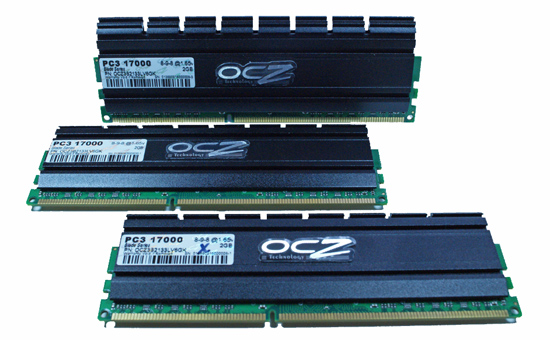Memory Scaling on Core i7 - Is DDR3-1066 Really the Best Choice?
by Gary Key on June 24, 2009 9:00 AM EST- Posted in
- Memory
Memory Prelude
Intel designed Core i7’s performance around triple-channel mode and low latency DDR3-1066. In fact, with three channels of DDR3-1066 memory, the platform will provide up to 25.6GB/s of memory bandwidth and nearly 38.4GB/s at JDEC approved DDR3-1600 memory speeds. Intel figures the bandwidth numbers available at DDR3-1066 coupled with the on-die memory controller and relatively fast secondary cache speeds should provide enough performance to satisfy anyone. For the most part, they are right.
However, we are never satisfied so we set out to determine if applications we utilize everyday would benefit from increased bandwidth, improved latencies, or a combination of both. Obviously synthetic memory benchmarks improve greatly as you increase bandwidth and decrease latencies. The memory companies (with help from us at times) tout their latest and greatest memory products with these benchmarks while they are staples on the benchmarking circuit.

We were discussing our initial overclocking results with a couple of BIOS engineers and came away surprised. We learned they typically tune memory performance utilizing a combination of Sandra/Everest and Super Pi. That did not shock us but it explains why time after time our various test systems would perform exceptionally well in the synthetic benchmarks and then fall flat on their collective faces when faced with heavy multitasking situations. We believe too much emphasis is placed on trying to win a benchmark that in no way reflects the true performance of applications or enhances the stability of the system.
That brings us to another story. We had planned to incorporate a full overclocking section in this article but our DDR3-1866 and DDR3-2000 kits based on the Elpida DJ1108BASE, err Hyper ICs, have been experiencing technical difficulties as of late. As in, the damn things are failing faster than we can keep replacements in the labs. This is not a vendor specific problem, nor does it seem to be a voltage problem either, as we have had modules from various suppliers fail at stock VDimm or at 1.8V when trying to push through to the DDR3-2300 level. We have asked the memory suppliers a few pointed questions and are waiting for answers. In the meantime, replacements are arriving shortly. We will follow up with additional DDR3-2000 overclocking scenarios in the near future.










47 Comments
View All Comments
sonci - Thursday, June 25, 2009 - link
The title was enough,and yours is too..
goinginstyle - Wednesday, June 24, 2009 - link
I have no idea where you have been hiding Gary but it is great to see you back. I look forward to the AMD article and the individual module tests. If they are half as good as this, I will be one happy person. Any chance or comments on Virtualization benches under WIn7 with XP?duploxxx - Wednesday, June 24, 2009 - link
very nice article with real world applications, now can you pls do the same with amount of dimms used and finally kill this marketing hype?vailr - Wednesday, June 24, 2009 - link
Re:"Current JDEC specifications list 1.50V as the official voltage specification for DDR3 with a move to 1.35V in the near future and eventually to 1.20V."
How does DDR5 (already being used on some video cards) voltages compare with those numbers?
Any predictions on when DDR5 memory modules for main boards might be introduced?
Are lower latency DDR3 modules "in the works"?
Maybe such a thing as:
1333 MHz @4-4-4-12 & 1.20v, for example?
Also: Intel promotes the benefits of using Hafnium when producing their CPU's. Would Hafnium also benefit memory chips?
GourdFreeMan - Thursday, June 25, 2009 - link
The video cards you are thinking of use GDDR, not DDR. You will never find GDDR packaged on DIMMs for motherboard memory slots, but rather only as individual chips for graphics boards and consoles. Though they share some technologies, you would need a different memory controller to make use of it. Typically GDDR5 runs from 1V to 1.4V (the GDDR5 on the stock Radeon HD 4770 runs at 1.263V for example). Hafnium dioxide has already been used by some manufacturers as the dielectric material in DRAM capacitors, and I know NEC, at least, has already used Hafnium in transistor gates for embedded DRAM. As for higher speed and lower latency RAM, that is pretty much always in the works...Zorlac - Wednesday, June 24, 2009 - link
I have thought this all along, but was too lazy to prove it. Thanks Anand!!! :)Any idea when we will start seeing 4GB DIMMs for running 3x4GB kits?
Gary Key - Wednesday, June 24, 2009 - link
We just finished testing a 12GB 1600 C9 kit from Kingston, but the street price is $1400. I also have a 24GB kit from Corsair, but I will not even mention the cost on that one. We should see affordable (compared to buying 6x2GB) 12GB kits later this year in the 1333 C8 variety without ECC. I do have a 12GB ECC Kingston 1066 C8 kit arriving shortly, retail is about $320, to test in some workstation products.DXRick - Wednesday, June 24, 2009 - link
It looks like the sweet spot is 1600 C8 at around $100 for a 6BG kit.vol7ron - Wednesday, June 24, 2009 - link
agreed --- those saying 1333 really are saving the buckI would still like to see SuperPi tests, since they are a mathematical approach to memory performance.
Gary Key - Wednesday, June 24, 2009 - link
Super Pi results will come in Raja's 2000 shootout. However, most of the Super Pi program runs in cache and when it goes outside of it,it only hits a couple of ranks in short bursts (why bandwidth matters) and as a result a proper loading of the entire memory subsystem is not really tested thoroughly. That said, we will have a complete subsection on Super Pi for the overclocking crowd. :)